This is Surveyor 3 in the most recent released image.
Phil
Click to view attachment
Full Version: Unmanned landing sites from LRO
Great work as always Phil.
Thought I'd try a bit of reverse Phil-O-Vision and squish rather that stretch the image to reduce the shadow to something more in scale for the Surveyor vehicle. Here's the comparison.
Click to view attachment
Thought I'd try a bit of reverse Phil-O-Vision and squish rather that stretch the image to reduce the shadow to something more in scale for the Surveyor vehicle. Here's the comparison.
Click to view attachment
Here is a tortured enhancement of LUNOKHOD 2 made from the LRO image
I found a site that has many VRML models of Russian spaceships.
http://vsm.host.ru/e_vrml.htm All I can discern it is run by a guy named 'chernov' (nice site!)
Click to view attachment
I oriented the model (approximately) as seen from above as in the images
Cheers
I found a site that has many VRML models of Russian spaceships.
http://vsm.host.ru/e_vrml.htm All I can discern it is run by a guy named 'chernov' (nice site!)
Click to view attachment
I oriented the model (approximately) as seen from above as in the images
Cheers
Interesting!
By the way, only a couple of weeks until the next LROC release - June 15th...
Phil
By the way, only a couple of weeks until the next LROC release - June 15th...
Phil
This is a possible candidate for the Chang-e-1 impact crater. I have done a comparison of Apollo 15 Metric camera image AS15-M-2003 with LROC M106533362RE, and some nice-looking craters in LROC were already there for Apollo 15. This one is on the verge of detectability in the Apollo frame, but just possibly might be new. I don't have the Apollo panoramic image yet to confirm it.
Phil
Click to view attachment
Phil
Click to view attachment
Another possible impact crater... this might be SMART-1. If so, it just skimmed the crest of the mountain in the top image (approaching from the north) and hit the surface slightly to the south of it. I don't know how plausible that is, but I don't see another candidate site yet.
Phil
Click to view attachment
Phil
Click to view attachment
The new release is out... and to celebrate it, here's Surveyor 7 casting a nice shadow.
Phil
Click to view attachment
Phil
Click to view attachment
... and the nearby 'playa' which was the actual landing target. Nice gullies!
(the image number is in the filename if you save these images)
Phil
Click to view attachment
(the image number is in the filename if you save these images)
Phil
Click to view attachment
I have waited to see this for so long. WOW!
Click to view attachment
This is an extreme enlargement of the area around Surveyor 7 in that image, fitted to craters in the detailed site plan in my Atlas, and with Surveyor 7 placed in its correct location and orientation. The spacecraft drawing doesn't show the solar panel/antenna assembly to avoid hiding objects beneath it.
Phil
This is an extreme enlargement of the area around Surveyor 7 in that image, fitted to craters in the detailed site plan in my Atlas, and with Surveyor 7 placed in its correct location and orientation. The spacecraft drawing doesn't show the solar panel/antenna assembly to avoid hiding objects beneath it.
Phil
How extremely nice ... I am just looking at your Atlas tome. Good fit, Phil !
Thanks, Kenny!
Phil
Phil
Wow! Slightly OT, but is that a 'pond' of impact melt? And what are those 'knobs' near Surveyor?
P
P
Yes, it's one of many ponds of impact melt around Tycho. The pattern of cracks is quite typical. I'm not sure which knobs you're referring to, but probably what you are describing are just rocks. This was quite a rocky site, as you can see if you look at the Surveyor 7 panorama (Google will lead you to it).
Phil
Phil
Here's a nice recently released LROC image of the tracks of Lunokhod 2, where it crossed a faint depression that they called "unnoticed rille". The image number is in the file name.
Phil
Click to view attachment
Phil
Click to view attachment
Supposedly the LRO has imaged the Lunar 23 & 24 landing sites:
Motherboard: Soviet Moon Mystery Solved by NASA, 50 years later
Rather sadly the images are not included in the linked article.
Motherboard: Soviet Moon Mystery Solved by NASA, 50 years later
Rather sadly the images are not included in the linked article.
Supposedly the LRO has imaged the Lunar 23 & 24 landing sites:
---
Rather sadly the images are not included in the linked article.
---
Rather sadly the images are not included in the linked article.
Actually she do have images on her page also, click at below right of the image at 'next'. The one linked by Deception is uncropped so even better though.
Luna 23 was an LPOD a few days ago. I have to say i'm not sure I can accept the new interpretation that the big white lump is the return capsule and the vehicle fell over. It transmitted to Earth for several days. The older interpretation from the first LROC images of it was that the lump was a rock which damaged the lander (i.e. it struck a glancing blow during landing). Seems more likely to me, but I suppose shadow analysis might help reveal the difference.
Phil
Phil
even before these images were released, the Lavochkin website was stating that Luna 23 had landed with too great a horizontal speed and on an unfavorable slope and toppled over, damaging the drill and depressurizing
Interesting... but I never heard that stated before. It was always just 'landed too hard' or something similar. I wonder where this comes from.
Phil
Phil
I have been reading the article "Declassifying the Space Race - part 2" in the October issue of Aerospace America (http://www.aerospaceamerica.org/Pages/TableOfContents.aspx)
interesting things: apparently the National Security Agency had means of intercepting the full telemetry of some Soviet probes including Luna 18 and 20. A detailed timeline of events concerning the latter is given, and as to the former, the NSA apparently used a tracking software fed with Soviet tracking data (!)
the NSA also wrote: "The landing site of Luna 20 is very near that of Luna 18 which crashed to the surface at 03-43N, 056-30E on 11 September 1971". the author notes that this differs from the official impact point, which is given (see for ex http://www.laspace.ru/rus/luna18.html) as 3° 34' N, 56° 30' E. and adds "To date, amateur astronomers using the official Russian location data have been unable to find Luna 18's crash site via NASA's photographic archives from its Lunar Reconnaissance Orbiter program."
I suspect that this is just a typing error in the NSA report, but I was wondering: do LRO imagery of 3° 43' N, 56° 30' E exist?
interesting things: apparently the National Security Agency had means of intercepting the full telemetry of some Soviet probes including Luna 18 and 20. A detailed timeline of events concerning the latter is given, and as to the former, the NSA apparently used a tracking software fed with Soviet tracking data (!)
the NSA also wrote: "The landing site of Luna 20 is very near that of Luna 18 which crashed to the surface at 03-43N, 056-30E on 11 September 1971". the author notes that this differs from the official impact point, which is given (see for ex http://www.laspace.ru/rus/luna18.html) as 3° 34' N, 56° 30' E. and adds "To date, amateur astronomers using the official Russian location data have been unable to find Luna 18's crash site via NASA's photographic archives from its Lunar Reconnaissance Orbiter program."
I suspect that this is just a typing error in the NSA report, but I was wondering: do LRO imagery of 3° 43' N, 56° 30' E exist?
I suspect that this is just a typing error in the NSA report, but I was wondering: do LRO imagery of 3° 43' N, 56° 30' E exist?
LROC image search http://wms.lroc.asu.edu/lroc/search gives me more then 300 possible images for this location, so it is covered by LRO.
http://wms.lroc.asu.edu/lroc/view_lroc/LRO....0/M192588983LC should cover it, afaik, but there are far more options.
Just like you, however, I suspect this is a typing error in the NSA report, and I doubt whether they know any better then the Soviets where Luna 18 ended up. The Lavochin description on the website you stated earlier differs quite strongly from several other publications and gives the impression that Luna 18 lost comms much earlier in the descent then previously was stated, making it more likely it completely smashed to smithereens and all we might ever find of it is a crater.
As I read my translation from the Lavochin state, Luna 18 suffered engine/stabilisation problems already during LOI due to a blocking in the oxidizer supply to one of the engines controlling the pitch. Due to this error, LOI was cut short by 15 seconds and it ended up in the wrong orbit altogether, loosing a lot of extra fuel in attempts to compensate. When finally a landing was attempted, it lost stabilisation and crashed.
What confuses me however is that this sounds very much like all descriptions of Luna 15, while I've never seen any other publication stating that Luna 18 ended up the wrong orbit after LOI..
Other publications and statements often seem to suggest that Luna 18 either lost radar-lock or ran out of fuel at very low altitude (some state after the vernier engines took over on final approach, which is at aprox. 20 mtrs above the surface). If that is true, we might find some wreckage aka Luna 23 and the candidate Phil Stooke earlier pointed to seems most likely. If the Lavochin site is correct (and they are the ones who should know, I would say) then there were already so many problems just steering it in the correct orbit and with the thing loosing stabilisation early in the burn, it might have come down anywhere and the coordinates they give is probably only the best guess or the intended location. I hope someone finds it, but it's a big area to search and lots of stones and craters down there.
I would still like to see if there is any sign of Surveyor IV in Sinus Medii. The best co-ordinates for the intended landing site I can find are 0.4N and 1.33W.
Yeah, I know that if the solid retro exploded as it neared exhaustion the craft would have been too far up for anything truly recognizable to be left after the shrapnel hit the surface. But there is always that tiny chance that Surveyor IV actually completed its landing safely and the failure was simply with the comm system.
I wonder if anyone has ever looked for either a landed Surveyor within the targeted footprint, or a set of craters where the pieces could have fallen...?
-the other Doug
Yeah, I know that if the solid retro exploded as it neared exhaustion the craft would have been too far up for anything truly recognizable to be left after the shrapnel hit the surface. But there is always that tiny chance that Surveyor IV actually completed its landing safely and the failure was simply with the comm system.
I wonder if anyone has ever looked for either a landed Surveyor within the targeted footprint, or a set of craters where the pieces could have fallen...?
-the other Doug
Interesting paper about Luna landers: http://www.sciencedirect.com/science/artic...3312003078?v=s5
This is a possible site for the Apollo 14 LM ascent stage. It's the same dark spot which I posted a view of several years ago, but now in a better image. It is within a few km of the dark spot Ewen Whittaker thought might be the impact point but not exactly the same.
Phil
Click to view attachment
Phil
Click to view attachment
The most interesting object I found in my searches of the Moon.
Initially I thought it was Luna 13. I still can't get it out of my mind that it is some man made probe, what do you think?

Initially I thought it was Luna 13. I still can't get it out of my mind that it is some man made probe, what do you think?

The most interesting object I found in my searches of the Moon.
Definitely interesting and close to the expected position of Luna 13, but I wonder about the size, it seems to me somewhat too big. Remember the E6 landers were just 58 centimeters in diameter, and although the outfolded pedals make it slightly bigger that's still only very close to the maximum resolution of the LRO camera, in other words they won't be more then a few pixels at most and this object seems a lot larger.
It clearly casts a shadow, so that might help also, if you know the sun-angle at the time the picture was taken, you can use that to calculate an estimate of the height of the object, see if this confirms with the E6 landers.
And, finally, if this is Luna 13, you should be able to find more objects in the vicinity. The cruise-stage landed at very low speed and should have come down more or less intact in the vicinity of the lander (in fact, the cruise stage was considerably larger then the lander, you might find the cruise stage first, and then the lander, or the object you have found might be the cruise stage). On the panorama pictures from Luna 13 you can see some objects on the surface, and some of them seem to be part of the spacecraft itself, see if they match with your observation!
Luna 13 is definitely making a chance to be found, I would guess. We know it landed on a relatively flat, featureless, plane with not many big stones or suchlike lying around, so provided there are sufficient shadows it should stand out. The small size of these landers is however what makes it so hard, they were really small and close to the limits of the LRO camera system.
Thanks for the input Geert,
I do have the NACS with the object and there is anothe object close by I will post them. Can you explain calculating sun angle to get size? I find it hard to measure using the measuring tool in ACT-REACT.
I do have the NACS with the object and there is anothe object close by I will post them. Can you explain calculating sun angle to get size? I find it hard to measure using the measuring tool in ACT-REACT.
Here are the NAC strips with the object.
I have already shown this object to Phil and he does not think that it is Luna 13, I agree but I can't get it out of my head that it is something man made, maybe an unknown probe no one said anything about.
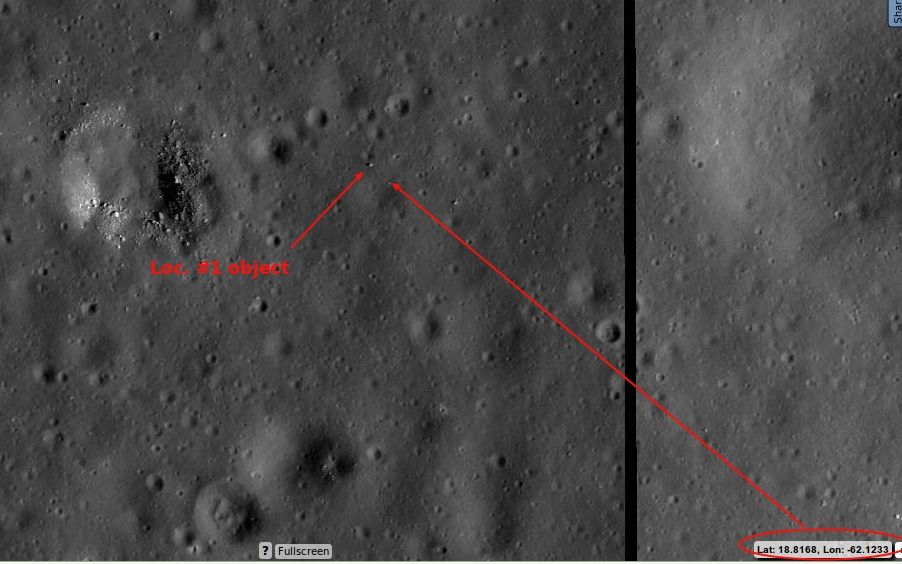
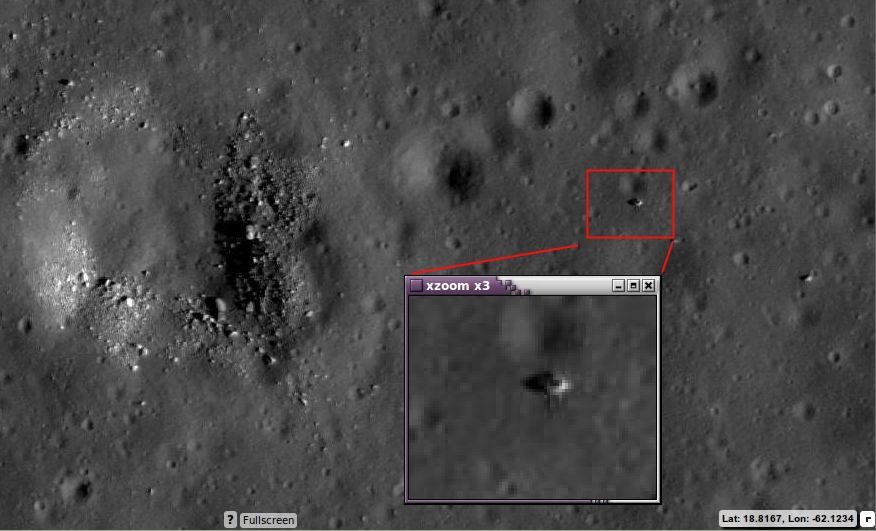
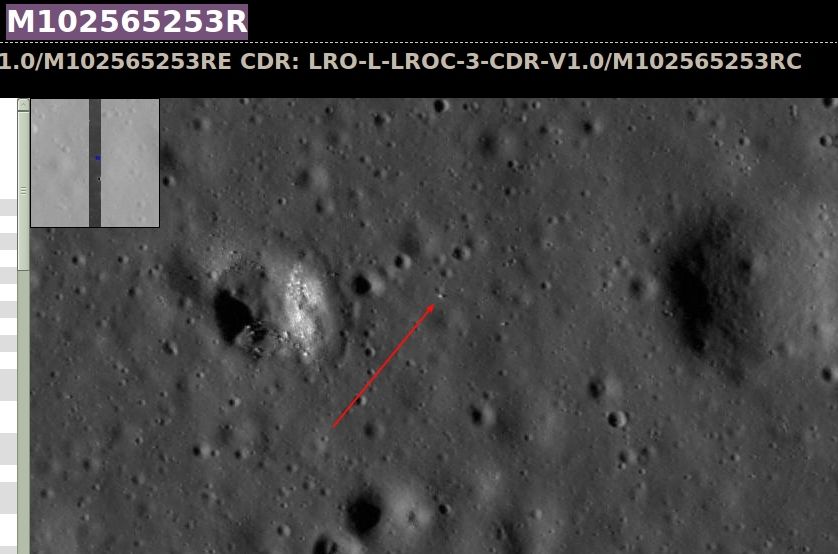
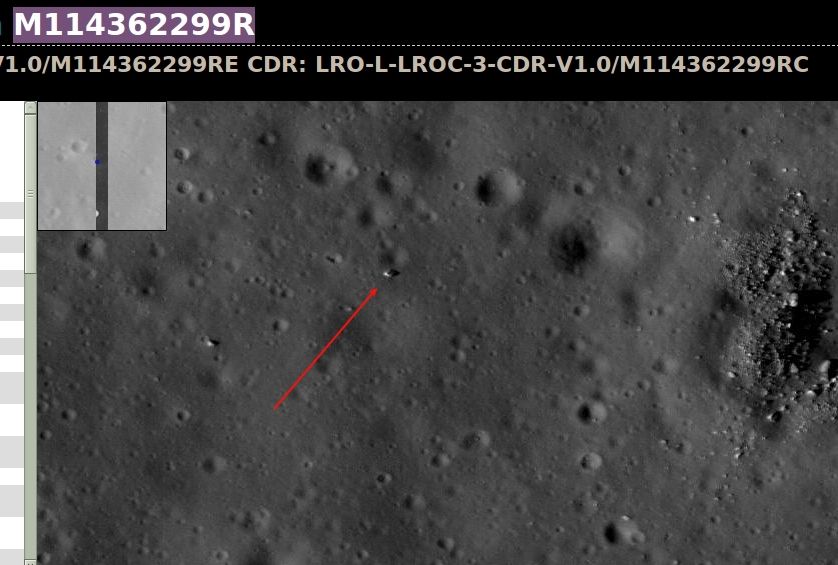
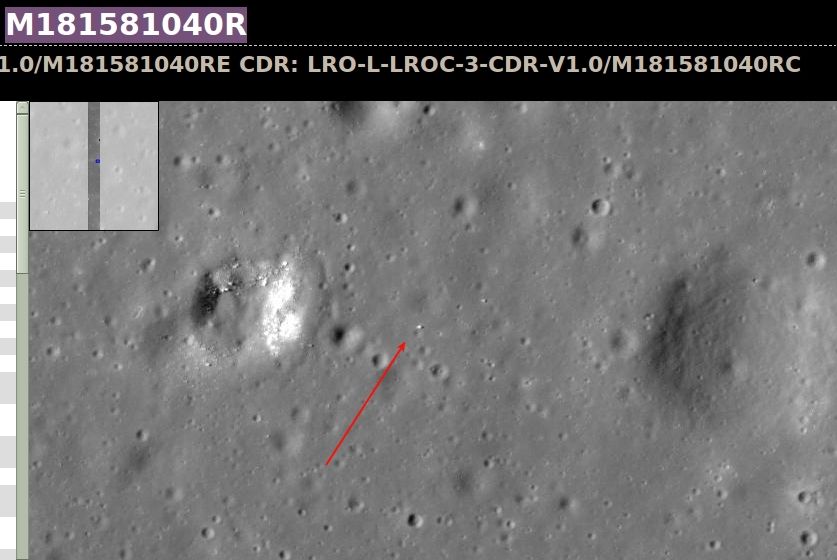
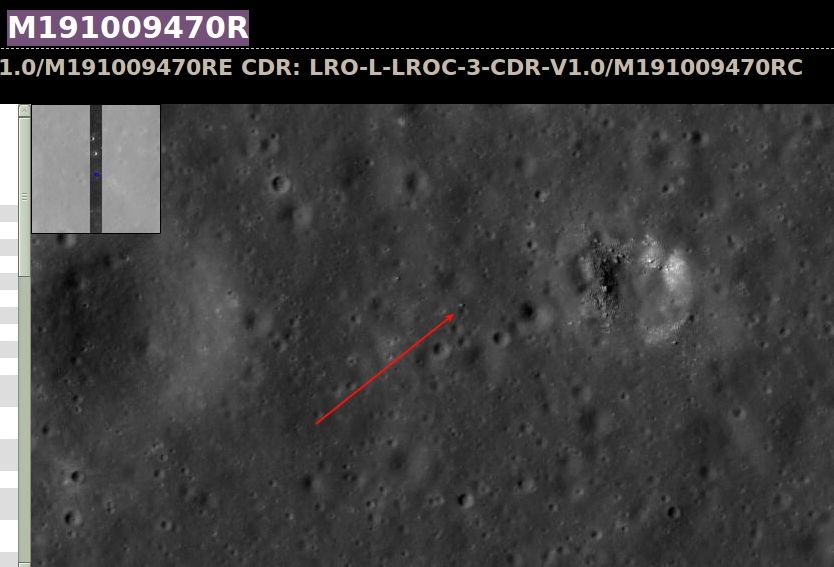
I have already shown this object to Phil and he does not think that it is Luna 13, I agree but I can't get it out of my head that it is something man made, maybe an unknown probe no one said anything about.






This is a very interesting object, but of course there is no other lander in the vicinity and the features around it do not match the pattern of craters imaged by Luna 13 (since they cover a much larger area than Luna 13 itself, they are going to be the deciding factor). So it has to be just a rock, but a very interesting rock. Note that the two lines extending from it are probably artifacts of the compression algorithm.
Apart from the successful Luna 9 & 13, Lunas 7 and 8 also reached that part of the Moon, impacting
at high speed. According to NSSDC, Luna 7 impacted at 9.8 N, 47.8 W, while Luna 8 impacted
at 9.1 N, 63.3 W. Impact speed would have been up to ~3 km/s, perhaps lower for Luna 8 if you believe one story
that the retrorockets fired late. On the premise that metal does not completely vapourise under these conditions, there should
be a couple of interesting debris-littered craters somewhere in the W part of the Ocean of storms.
Tolis.
at high speed. According to NSSDC, Luna 7 impacted at 9.8 N, 47.8 W, while Luna 8 impacted
at 9.1 N, 63.3 W. Impact speed would have been up to ~3 km/s, perhaps lower for Luna 8 if you believe one story
that the retrorockets fired late. On the premise that metal does not completely vapourise under these conditions, there should
be a couple of interesting debris-littered craters somewhere in the W part of the Ocean of storms.
Tolis.
This is an image I sent to Jason which shows more what I would be looking for at the Luna 13 location. The arrow points to a small lump inside a crater which also contains another crater - the pattern of features imaged by Luna 13 according to the map drawn by Soviet scientists at the time. Looking towards the horizon the images suggest a very subdued larger crater north of the lander. So the general pattern seen here should be roughly what we would expect. This one is not quite right - some other small features nearby don't show up as I would expect. But it's pretty close. (we might also expect a bright blast pattern around the lander caused by its braking stage - as well as the stage itself crashed nearby)
Phil
Click to view attachment
Phil
Click to view attachment
This is the Surveyor 1 site imaged by LROC - the image number is in the file name if you save it. I have indicated the Surveyor itself. Northwest of it is a small dark spot, which by analogy with the similar feature at Surveyor 3 I think might be the retro-rocket impact site. At Surveyor 3 there was a pre-landing Lunar Orbiter image to confirm that the spot was a new feature. Here there is not - Surveyor 1 landed before Lunar Orbiter 1 was launched. So I can't be certain, but it's a reasonable match to what I would expect.
Phil
Click to view attachment
Phil
Click to view attachment
I've just noticed this interesting post. This suspected motor is displaced northwards of the landing site, just like the Surveyor 3 suspected one, albeit Surveyor 1's has a big westward component.
(Assuming north is up, which I think it is.) I recall that we searched the Apollo 12 surface photos looking out in that direction, with no result. Alan Bean confirmed to me that they never went up to that area,
and had no opinion on that being the descent motor. I'm trying to find out if there was any expected consistency in the displacement of these motors from the lander after release.
(Assuming north is up, which I think it is.) I recall that we searched the Apollo 12 surface photos looking out in that direction, with no result. Alan Bean confirmed to me that they never went up to that area,
and had no opinion on that being the descent motor. I'm trying to find out if there was any expected consistency in the displacement of these motors from the lander after release.
not a landing site but... LRO has imaged LADEE zooming by!
http://lroc.sese.asu.edu/news/index.php?/a...unter!.html
http://lroc.sese.asu.edu/news/index.php?/a...unter!.html
RE: LRO imaging LADEE -- amazing! Reading the article linked by Paolo reminds me how clever and how capable are the folks who create these spacecraft and operate them.
That's immensely impressive that they were able to resolve structures on LADEE. 
New LROC images of Chang-e 3's landing site.
Excellent! Looking carefully at a blow-up of the GIF sequence, it looks like there might have been a very small movement backwards on day 3. Still trying to decide iif it's real or an effect of the different lighting. EDIT - no, there's no movement at all when perfectly registered...
Phil
Phil
Here are two LROC images of lunar hardware... possible identifications of the retrorockets of Surveyors 5 and 6.
Each Surveyor was slowed during its approach to the surface by a rocket mounted underneath the lander. It and its fuel tank were ejected a little way above the surface and fell to the surface at relatively low velocity. The lander continued to the surface supported by three small 'vernier' thrusters (except Surveyor 4 which failed at the point of rocket separation... Surveyor 2 failed much earlier in its flight).
Can the retro-rockets be identified in LRO images? I previously put up an image of Surveyor 3's retrorocket, which is not in doubt as a correct identification because we have pre-landing Lunar Orbiter images, and a dark spot in LRO images is not present in the old images.
A few posts up in the thread I suggested a possible candidate for Surveyor 1's retrorocket. It's not certain but it's possible. Here I show images for Surveyors 5 and 6. I use the highest sun image to look for dark spots. In each case there is only one good candidate. And each one has a short trail of dark spots leading to (or from) it as if the tank rolled or bounced a bit. I don't know if the dark spot is the impact point or the hardware itself, i.e. I don't know which way the object moved along that possible trail of spots. Surveyor 3's candidate has the same trail of spots. Therefore, I think these are very promising identifications.
Surveyor 7 is never seen with sun near the zenith and I have not yet found a candidate rocket. Surveyor 1 doesn't have a very good high sun image either, and I'm not so convinced that my suggestion is correct.
Phil
Click to view attachment
Click to view attachment
Each Surveyor was slowed during its approach to the surface by a rocket mounted underneath the lander. It and its fuel tank were ejected a little way above the surface and fell to the surface at relatively low velocity. The lander continued to the surface supported by three small 'vernier' thrusters (except Surveyor 4 which failed at the point of rocket separation... Surveyor 2 failed much earlier in its flight).
Can the retro-rockets be identified in LRO images? I previously put up an image of Surveyor 3's retrorocket, which is not in doubt as a correct identification because we have pre-landing Lunar Orbiter images, and a dark spot in LRO images is not present in the old images.
A few posts up in the thread I suggested a possible candidate for Surveyor 1's retrorocket. It's not certain but it's possible. Here I show images for Surveyors 5 and 6. I use the highest sun image to look for dark spots. In each case there is only one good candidate. And each one has a short trail of dark spots leading to (or from) it as if the tank rolled or bounced a bit. I don't know if the dark spot is the impact point or the hardware itself, i.e. I don't know which way the object moved along that possible trail of spots. Surveyor 3's candidate has the same trail of spots. Therefore, I think these are very promising identifications.
Surveyor 7 is never seen with sun near the zenith and I have not yet found a candidate rocket. Surveyor 1 doesn't have a very good high sun image either, and I'm not so convinced that my suggestion is correct.
Phil
Click to view attachment
Click to view attachment
Looks like Surveyor V's retro-rocket (if you have it correctly identified, and I think you do, Phil) might have rolled a distance before it came to rest. They weren't coming in fast enough to dig deep craters, so I guess it doesn't surprise me that one might roll a bit.
Since at these high-sun conditions the topography becomes completely washed out, it's hard to tell if maybe V's retro might not have rolled down into a shallow crater. As it's darned near impossible to get the original TIFFs from the LROC website anymore, I don't have the best way to go looking for lower-sun images of the site to check for such a shallow crater. Could you take a look and see if my theory holds any water, here, Phil?
Oh -- I looked upthread, all the way to where I began the thread more than five years ago, and I didn't see any posts of the likely Surveyor III retro's final resting place, even though I know I've looked myself and have suspected a suspicious object to the north of the landing site. Could you point me to where you posted your identification? I'd like to look at it myself (assuming I haven't already -- age plus the heavy painkillers for so many months before and after these darned surgeries have not done good things for my memory, it seems).
-the other Doug
Since at these high-sun conditions the topography becomes completely washed out, it's hard to tell if maybe V's retro might not have rolled down into a shallow crater. As it's darned near impossible to get the original TIFFs from the LROC website anymore, I don't have the best way to go looking for lower-sun images of the site to check for such a shallow crater. Could you take a look and see if my theory holds any water, here, Phil?
Oh -- I looked upthread, all the way to where I began the thread more than five years ago, and I didn't see any posts of the likely Surveyor III retro's final resting place, even though I know I've looked myself and have suspected a suspicious object to the north of the landing site. Could you point me to where you posted your identification? I'd like to look at it myself (assuming I haven't already -- age plus the heavy painkillers for so many months before and after these darned surgeries have not done good things for my memory, it seems).
-the other Doug
Thanks, Phil! Yeah, that was the thing I saw in the early LROC images of the Surveyor III site that I thought might be the retro. Somehow, I don't recall seeing that thread -- and that's unusual for me. Again, I plead painkillers... 
I agree that it's going to be way easier to find hardware on the Moon in the LROC images taken at very high sun angles than the low sun angle images, and I must say you've been having great success at it. It's great to see every new little bit of hardware we've left up there, and you more than most have been the best at finding things. It's a privilege to watch.
But in some cases, after finding the stuff, it also seems to me that it can inform the "dark blob" images if you know if there are, say, local slopes or other landforms that act to modify the piece of hardware's "look," and that aren't very obvious under a high sun. The kind of stuff you would see much better at lower sun angles. So, just sort of thinking, if after finding things, do you also look at them at lower sun angles, too? Are they usually available at the same resolution at lower sun angles?
Or is it something of a crapshoot, even now?
-the other Doug
I agree that it's going to be way easier to find hardware on the Moon in the LROC images taken at very high sun angles than the low sun angle images, and I must say you've been having great success at it. It's great to see every new little bit of hardware we've left up there, and you more than most have been the best at finding things. It's a privilege to watch.
But in some cases, after finding the stuff, it also seems to me that it can inform the "dark blob" images if you know if there are, say, local slopes or other landforms that act to modify the piece of hardware's "look," and that aren't very obvious under a high sun. The kind of stuff you would see much better at lower sun angles. So, just sort of thinking, if after finding things, do you also look at them at lower sun angles, too? Are they usually available at the same resolution at lower sun angles?
Or is it something of a crapshoot, even now?
-the other Doug
Doug, usually there is very little to see in the low sun views at those locations.
The site you crave with every fibre of your being is this one:
http://lroc.sese.asu.edu/featured_sites
For this purpose you can go to the Surveyor link, and for each Surveyor you can view individual images, and flip-books which let you scan from morning to evening illumination. And there are lots of other sites to look at as well.
I've looked at pretty much every one of these images now.
Phil
The site you crave with every fibre of your being is this one:
http://lroc.sese.asu.edu/featured_sites
For this purpose you can go to the Surveyor link, and for each Surveyor you can view individual images, and flip-books which let you scan from morning to evening illumination. And there are lots of other sites to look at as well.
I've looked at pretty much every one of these images now.
Phil
A follow-up on Surveyor 3.
Click to view attachment
At left, an LROC image (M175428601R). At right, part of Lunar Orbiter 3 frame 154H2, taken before the Surveyor 3 landing.
This is the first time I have seen the retro-rocket impact at low sun, and the dark spot discussed earlier is revealed to be a crater with a central lump - the fuel tank and/or other components sitting right there. The crater clearly does not exist in the Lunar Orbiter image despite the lower resolution.
Phil
Click to view attachment
At left, an LROC image (M175428601R). At right, part of Lunar Orbiter 3 frame 154H2, taken before the Surveyor 3 landing.
This is the first time I have seen the retro-rocket impact at low sun, and the dark spot discussed earlier is revealed to be a crater with a central lump - the fuel tank and/or other components sitting right there. The crater clearly does not exist in the Lunar Orbiter image despite the lower resolution.
Phil
That's a really cool find! IIRC the impact velocity was fairly low; amazing that the hardware seemingly survived yet produced such a substantial crater.
Phil, can you give an estimate of the size of that crater?
This is a "lo-fi" version of our main content. To view the full version with more information, formatting and images, please click here.
